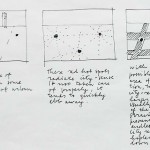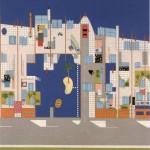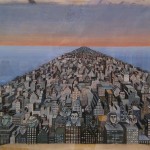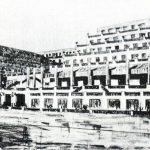
The surrealist theorem of the Cadavre Exquis was studied and applied by Rem Koolhaas since the beginning of his architectural practice. In a later variation it allowed different members of the Office for Metropolitan Architecture to work separately on different parts of a project and assemble them only later through group sessions.
This working method suited particolarly well the demands of the 1978 competition for the Dutch Parliament Extension in the Binnenhof complex (at the heart of The Hague), allowing the team (at the time composed by Koolhaas, Elia Zenghelis and a freshly graduated Zaha Hadid) to interpret and stress the caothic historical development of the area.
The Binnenhof complex went through an uninterrupted process of architectural and programmatic trasformations, leading to a final condition in which incoherent stratifications and abrupt solutions cohexisted.
The competition’s brief asked for an extension to the Parliament and also offered the participants the opportunity to revise the symbolic meaning of the complex: a symbolic and physical separation was demanded between the chamber of the government and the chamber of the representatives, the politicians who are charged to supervise the governmental’s deliberations. Although it was supposed to simplify that urban sector, the competition actually implied a new layer of complexity to the site.

“The Final Push”, colour Madelon Vriesendorp
The OMA solution reads and underlines this complexity, splitting the project into three different limbs developed independently by Rem Koolhaas, Elias Zenghelis and Zaha Hadid, in an episode of her short collaboration with her previous teachers.
Taking a distance from Dutch architecture, at the time still dominated by the “doctrine” of the Structuralism, by which larger programs were often to be subdivided into smaller units, OMA designs three large buildings assembled along two intersecting axes. The Zenghelis building is a low and large volume containing meeting rooms and public spaces, The Hadid building is a long and tall slab, parallel to the first and containing halls and offices for the politicians, and the Koolhaas sector is a volume generated by the extrusion of an informal plan and located upon pilotis.
The assembly phase determined the episodes of connection between the three buildings.
From the article on International Architect 03/1980 (from which the images were taken):
“In this work OMA is trying to salvage fragments of what it considers the original enterprise of Modern Architecture – represented by, for instance: Leonidov, Hilberseimer, Melnikov, the ‘Berlin’ Mies Van der Rohe, the Wright of Broadacre City, and the Hood of Rockfeller Center – ie- a campaign of territorial conquest for the programmatic imagination that claimed a role for architecture not only as the design for the sets of everyday life, but also in the formulation of the contects of culture. Among the tidal wave of current frivolity, it is important not to surrender the one ambition that connects architecture with ‘what happens’, since it triggers what happens”
The Dutch Parliament Extension – 1978
Office for Metropolitan Architecture (OMA)
Zaha Hadid, Rem Koolhaas, Elia Zenghelis
with: Richard Perlmutter, Ron Steiner, Elias Veneris
Model by: Batsheva and Shlomo Ronen
For an analysis of the project, read the OMA presentation of the project, at the end of the post.
Image top of the post: “Top of the Podium. Accomodation for orgies of speech”, colour Zoe zenghelis





Figure/Ground drawing of context

“The Ambulatory and its Connections” Zaha Hadid


OMA Description:
DUTCH PARLIAMENT EXTENSION, NETHERLANDS, THE HAGUE, 1978
Since in the 13th century, the Binnenhof complex has undergone a continuous process of both architectural and programmatic transformation in which its defensive forms were replaced by representative and symbolic functions. Over the centuries it has acted as a royal palace, archives, Republican headquarters, and then royal palace again, until it was completely ‘conquered’ in the 19th century, initially by various ministries and eventually by the parliament. In order to accommodate these changes in function, all architectural styles since the Middle Ages made significant and tangible contributions to the complex leading to incremental changes in the walls of the fortress, whereby the walls have become an agglomeration of different historical styles. Hide
Superimposed on these authentic changes is a layer of restorations intended to preserve the complex’s historicity, but which only proves that each act of preservation embodies a revision, a distortion, even a redesign. The largest single block of fabricated history is now the Ridderzaal, whose Gothic authenticity has been replaced by a 19th century restorative fantasy à la Viollet-le-Duc. There is very little medieval medieval architecture left; the Binnenhof has become a catalogue of medievalness.In 1978 a competition was held to correct this ambiguity. A vaguely triangular area east of the Binnenhof was designated as the site for a much-needed extension of the parliamentary accommodation. This extension also had to provide a restoration of symbolism, to separate conceptually government and the representatives who are supposed to supervise its actions.
In OMA’s proposal, the entire Binnenhof is seen as undergoing a permanent, slow-motion process of transformation, in which democratic institutions invade and appropriate the feudal typology of the Fortress. Only an architecture which is unapologetic about its modernity can preserve and articulate this tradition. In such an interpretation, all historicist doctrine represents, in fact, interruptions or even obstructions of this transformation.
According to this reading, the ‘conquest’ of the Binnenhof becomes final with the introduction of the new parliament itself: it is designed as the architectural representation of the final push which creates a breach of modernity in the walls of the Fortress itself.
The total program of the competition – for all the parliamentary facilities – was to be divided between a number of existing structures which had to be preserved on the one hand, and the new building(s) which had to represent the autonomy of the parliament on the other.
In OMA’s scheme, the tradition where each age manifests itself inside the walls of the Binnenhof is maintained through the transplantation of one 17th century structure to a position in front of the complex, where it partly undoes Berlage’s traffic cut and restores some of the original definition of the Buitenhof. The breach created by this removal is then occupied by two slabs: one horizontal, the other vertical.
The horizontal slab – a podium made of glass brick – contains the entire conference center. It is conceived as a covered podium for political activity, directly accessible to the general public from the adjoining plaza. The vertical slab contains accommodations for professional politicians. An ambulatory runs horizontally through the assembly, towards the ‘smoke-filled room’. Above the ambulatory are three floors where the thirteen political parties prepare their positions; from there they then filter down to the ambulatory and the assembly. Below the ambulatory are three floors for the managers of the parliamentary procedures.
The 340 rooms for the members of parliament and their assistants are accommodated in the existing structures along the Binnenhof; three of the five courtyards have been connected to form an arcade which directs all traffic towards a split ramp, and in turn leads directly to the ambulatory and to the basement of the conference hall.
In a project where a large number of programmatic elements are distributed over both new and existing structures and scattered over a vast site, the quality of the connections determines the quality of the project.
OMA’s scheme is based on two intersecting axes – one is the new arcade that runs north-south through the existing buildings; the other is the ambulatory, running east-west through the middle of the slab.
From the entrance, a system of escalators leads directly to the public gallery of the assembly hall, a rectangle that completely surrounds the parliamentarians. The entire mezzanine level contains facilities for the press: a linear beam of editorial offices and a suspended press plaza for more public events such as press conferences. On the ground floor, which basically serves as a lobby, segments are screened off for informal meetings. The oval structure contains three superimposed conference rooms connected by a spiraling ramp. The ground floor area also contains the reception and stage accommodation for the Department of Petitions (to the left); petitions are displayed in steel storage cabinets as tangible evidence of the volume of public participation in the parliamentary process.
OMA / REM KOOLHAAS, on Socks:
EXODUS, OR THE VOLUNTARY PRISONERS OF ARCHITECTURE
OMA’S PERFORMANCE IN “A SLICE OF MODERNITY / CASA PALESTRA, THE DOMESTIC PROJECT”, 1986 MILAN TRIENNALE
OMA/REM KOOLHAAS EARLY SKETCHES
ADAM SIMPSON, BOUNDARY HOTEL ELEVATOR (VS. OMA, EXPO 89, FRANCE, PARIS, 1989)
ZOE ZENGHELIS AND OMA
OMA’S 1989 SPORT CENTER PROJECT FOR NOORDDIJK, GRONINGEN, NETHERLANDS
STRATEGY OF THE VOID: BUILDING THE MODEL OF OMA’S TRÈS GRANDE BIBLIOTHÈQUE
OMA’S TRÈS GRANDE BIBLIOTHÈQUE – (MORE)
‘WE’RE BUILDING ASSEMBLY-LINE CITIES AND BUILDINGS’ – A KOOLHAAS INTERVIEW
POLÉMIQUE, ÇA VA SANS DIRE (KOOLHAAS @ CENTRE POMPIDOU)
R.E.M. KOOLHAAS





[…] Extension, OMA (Koolhaas, Zenghelis, Zaha Hadid) – 1978.” Socks. November 22, 2013. [access][3] Futagawa, Yukio, ed. GA Architect: Zaha M. Hadid. Tokyo: A.D.A. EDITA Tokyo, 1986. p38.[4] […]